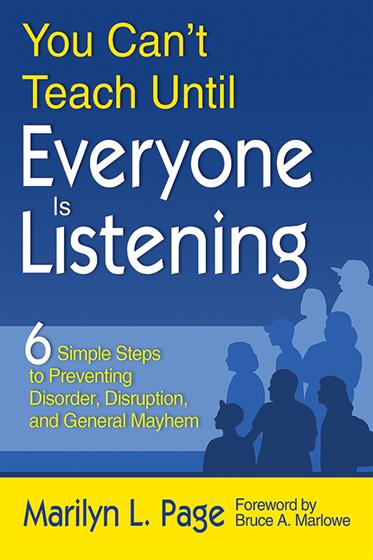Foreword by Bruce A. Marlowe
Preface
Acknowledgments
About the Author
Introduction
1. The Critical Beginning: Knowing and Using Students' Names
Barry
Knowing and Using Students' Names
Your Number 1 Classroom Management Tool
Student Teachers and Interns
Novice and Experienced Elementary Teachers
An Easy Strategy
Other Approaches
Back to Barry
Summary: Step 1
What Comes Next?
2. Avoiding Anonymous and Dangling Questions
Dave
Types of Questions Teachers Ask
Levels of Questions Teachers Ask
Dangling Questions: What Are They and What Was Dave Doing Wrong?
Students Left in the Dark
Worse Consequences
What Can You Do?
The Problems With Hand Raising
A Better Way
An Old Teacher's (or Is It Researcher's) Tale
The Results of These Better Strategies
Anonymous Questions: What Are They?
What's Wrong With These Questions?
How Can a Teacher Fix This?
Did Dave Recover?
The Experiment
The Results
Summary: Step 2
What's Next?
3. Choosing and Using Words Wisely
Mariah
Mariah's Goal
What's in a Word?
The Importance of Tight and Professional Language
What Are Filler Words?
What Happens When You Use Filler Words?
An Unprofessional Word
Mariah's Transformation
Terry
And Danae
Using Words of Civility in the Classroom
The Common Thread
Three Other Powerful Hints About Language
Making These Language and Tone Changes in Your Classroom
Summary: Step 3
Coming Attractions
4. Avoiding Confusion When Giving Directions
Elizabeth
Clarifying Directions
The Results
A Pilot Project: A Different Story
Chris
What Are We Supposed to Do?
Giving Instructions That Don't Lead to Disruption
Why It's Important for Students to Re-explain
Back Up! We Are Missing Two Preliminary Steps
Chris' Plan
The Results
Summary: Step 4
What's Next?
5. Attending to Civility With Reminders and Cues
Seventh Period: A Special Ninth-Grade Class
The First Day of School
What Happened With This Class?
Mrs. Watkins' Advice
The Problem With Classroom Rules
Simple Expectations of Civility
Jeannie
Reminders and Cues
How Often Do You Have to Give Reminders or Cues?
Jeannie's Approach
The Results
The Bottom Line
Summary: Step 5
Coming Next
6. Upgrading Interactions: Can You Feel the Heartbeat?
The Title
Julia
Moving to a Higher Level
Challenging Julia
The Results
Two Challenges for You
How to Begin
What Can Go Wrong Here?
Subtle Classroom Disorder
Jake
Shy Students
Detached Students
National History Day
Phil
The Contest
The Points of This Story
The Results
The Ultimate Goal
Summary: Step 6
Now What?
7. Harry and Clara Reclaim Their Classes
Harry
Harry's Mistake: An Ultimatum
Harry's Meltdown and Recovery
The Letter
The Students' Responses
The Results
Streamlining Harry's Format
Clara
Clara's Approach
The Results
A Bonus: You Learn More Than You Think From Student Letters or Student Drawings
Your Turn
8. Making This Happen
Beginning
Teacher Preparation Courses and Preservice Teachers
University Professors
Student Teachers
Novice Teachers
Experienced Teachers
Bon Voyage
Appendix: Handling Unwanted and Inappropriate Responses
Examples
References
Index



